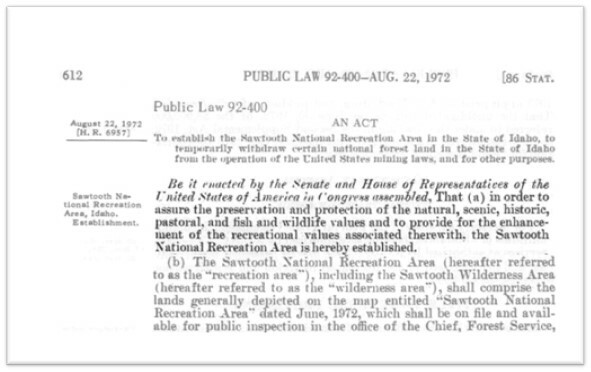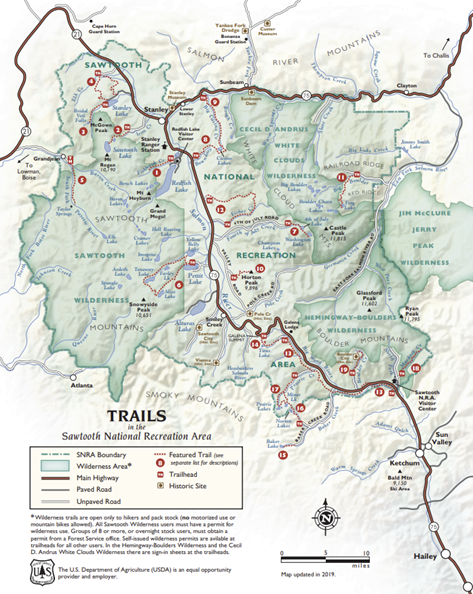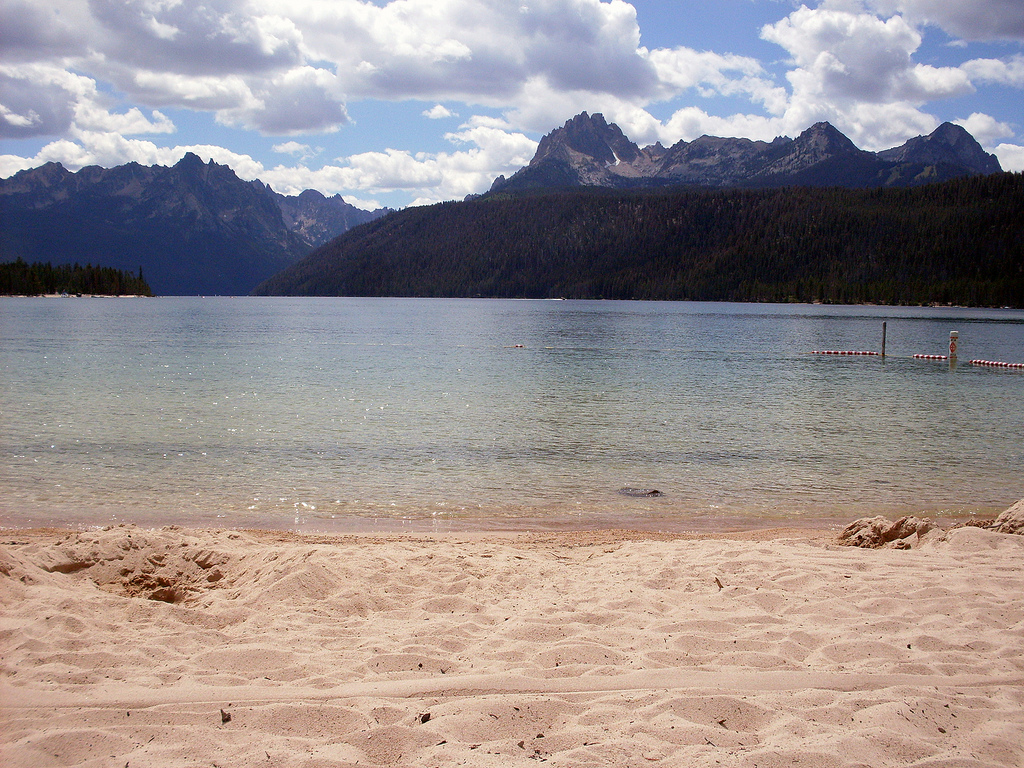There is a special part of Idaho known to locals and wide-ranging travelers alike; a particularly rugged and remote landscape that hosts more than 300 lakes and over 700 miles of trails. The mountain range and the surrounding alpine ecosystems hold the crown that other states reserve for their most treasured national parks. Idahoans have told me that what they have is even better than a national park. This is the Sawtooth National Recreation Area.
The Sawtooth National Recreation Area (NRA), a portion of the Sawtooth National Forest, encompasses 756,000 acres of federal, state, county, and privately-owned land including three wilderness areas and the small town of Stanley. The US Forest Service (USFS) Sawtooth NRA Area Ranger oversees the entirety of the Sawtooth NRA. This unique arrangement was established in 1972 when Congress passed Public Law 92-400 in recognition of the valuable qualities of the region.
NRAs are one of the many kinds of federal land designations. Unlike wilderness areas, which restrict motorized activities, or national parks, which typically aim to preserve the historic or cultural qualities of a landscape, the main intention of NRAs is to get Americans into the great outdoors. There are 40 NRAs across the country, managed by the National Park Service, the Bureau of Land Management, or the US Forest Service (USFS).

“…in order to assure the preservation and protection of the natural, scenic, historic, pastoral, and fish and wildlife values and to provide for the enhancement of the recreational values associated therewith, the Sawtooth National Recreation Area is hereby established.”
The Sawtooth NRA has captured the hearts of many, long before its present borders were established, and in each season since. Many people, including professional land managers and local residents, have dedicated significant parts of their lives and careers to protecting the integrity of the Sawtooth NRA as human development and activity spread into wild spaces. At different times, those efforts have resulted in formal agreements – the formation of new organizations or strategic plans; at other times, these players initiated informal or sporadic activities.
One of those formal initiatives took place in the early 2000s. Representatives from the USFS, nonprofits, and other local interest groups met to discuss challenges regarding each of the Sawtooth NRAs core values – natural, scenic, historic, pastoral, recreational, and quality fish and wildlife habitat – and the economic vitality of the surrounding communities. This diverse collection of stakeholders envisioned desired outcomes for the future of each of these topics, recorded in a summary and strategic plan titled Sawtooth Vision 20/20.

Map of the Sawtooth NRA, courtesy of the Sawtooth Society.
Sawtooth Vision 20/20 is still a valuable account of the challenges affecting the Sawtooth NRA values, among them the quality of salmon and other wildlife habitat; affordable housing for those who work to maintain the Sawtooth NRA; land development considered incongruent with pastoral, historic, and scenic values; fire management; invasive species; and respectful recreation. Stakeholders and the USFS have made progress on these issues, yet many challenges remain.
A new group of dedicated individuals is assembling to further the discussion of challenges and opportunities for partnerships on the Sawtooth NRA. I have had the pleasure of working with this group since September 2022. Over the last six months, I interviewed participants about their main concerns regarding the Sawtooth NRA and what they hoped to achieve by forming a new group. Participants also reviewed Sawtooth Vision 20/20 to reflect on the progress and urgency of issues. We at the NFF synthesized what we learned from these participants into a situation assessment and a set of recommendations: documents that appear in black and white type, but that spell out the nuances of the Sawtooth NRA and suggest a path forward for this group, the Sawtooth Coalition.

Redfish Lake, the largest lake within the Sawtooth National Recreation Area. Photo by Brandon Dalton.
It can be painstakingly slow to begin something new, especially a thoughtful process of communication. It can be confusing and frustrating to consider urgent issues while taking the time to organize thoughts into guiding documents. In the last six months I have recognized a pattern that I have experienced while participating in other groups, and also within myself: the overwhelming feeling that action must replace stasis even while the unknown future seems daunting, paralyzing. My position as a Conservation Connect Fellow with the NFF allows me to also see the bigger picture and appreciate the progress that the budding Sawtooth Coalition has made. This group will continue to evolve into yet unknown directions; yet we can rest assured that the result will be a thoughtful collective reflection on landscape-scale issues. In the making is a new example of how many minds and hearts enthralled with a place can take on the greatest issues.
Amelia Liberatore is a 2022 Conservation Connect Fellow pursuing a master's degree in Environmental Science and Natural Resource Journalism with a certificate in Natural Resource Conflict Resolution at the University of Montana. She strongly believes in the power of listening to one another’s stories to solve conflicts; that by changing our habits of communication, we can build relationships that inform and transcend social/political conflicts. Promoting this kind of communication is her fundamental aim as a writer, journalist, and community member.
Cover photo by the U.S. Forest Service.
--------
Bringing people together has always been a superpower of the NFF. But we can’t do it without our supporters, and that includes you. Please consider making an unrestricted gift today so we can provide the absolute best collaborative services tomorrow. Simply click here. We – and all our partners – thank you!

